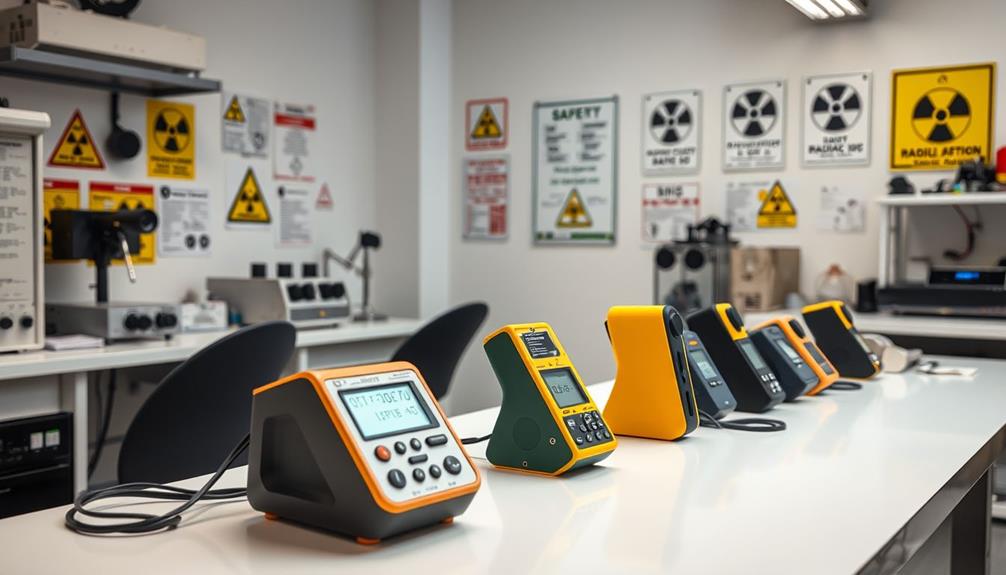To spot danger before it happens, you need to sharpen your threat awareness skills. Start by observing behavior for indicators like rapid movements or aggressive body language. Trust your instincts if a situation feels off, and maintain a safe distance from suspicious individuals. Enhance your situational awareness by knowing your environment, identifying exits, and recognizing hazards. Use personal safety tools responsibly and familiarize yourself with their operation. Regularly engage in safety drills and communicate plans with loved ones. These strategies can help prevent incidents before they escalate, and there’s much more to explore on building an effective safety culture. Additionally, it’s important to be prepared for unexpected threats, such as wildlife attacks. Research and practice wildlife attack response techniques, especially if you live or spend time in areas known for encounters with dangerous animals. Knowing how to react in these situations can be crucial for your safety and the safety of those around you. Stay informed and educated on all aspects of threat awareness to ensure you are well-equipped to handle any potential danger.
Key Takeaways
- Maintain situational awareness by observing your surroundings and recognizing behaviors that indicate potential threats, such as rapid movements or aggressive body language.
- Trust your instincts if a situation feels unsafe, and keep a safe distance from suspicious individuals to minimize risk.
- Familiarize yourself with emergency response plans and local services to prepare for potential threats effectively.
- Conduct regular safety assessments in your environment to identify and address hazards that could lead to dangerous situations.
- Stay informed about personal safety tools and their responsible use, ensuring they are accessible and functional in case of emergencies.
Understanding Active Threat Assessment

In today's unpredictable world, understanding active threat assessment is essential for maintaining safety in various environments. This methodology involves closely observing behaviors and actions to identify potential threats. By systematically scanning your surroundings, you can spot suspicious individuals—known as persons of interest (POIs)—who may display threat indicators, such as avoiding attention or showing signs of carrying a weapon.
When you identify POIs, you can monitor their activities more closely to assess the likelihood of violent behavior, such as targeting specific locations. This assessment focuses on short-term and medium-term threats, particularly those that arise just before an incident. By evaluating behavioral indicators, you can anticipate potential dangers before they escalate. Moreover, various assessment methods are crucial for active shooter prevention, with different communities requiring tailored threat assessment strategies.
Active threat assessment isn't just for law enforcement; it's also crucial for security personnel in schools, airports, and public events. Multi-disciplinary threat assessment and management teams (TATM) often coordinate efforts among various agencies to address high-risk cases effectively. By integrating advanced training and clear communication, you can enhance your ability to respond rapidly to threats, ensuring a safer environment for everyone involved.
Importance of Situational Awareness

Situational awareness is your best ally in maintaining personal safety and making informed decisions in any environment. By enhancing your ability to identify potential threats and changes around you, you can better protect yourself. This skill involves recognizing unusual or suspicious elements in your surroundings, allowing you to anticipate dangerous situations and know when to exit or seek help. Ethical hackers often utilize situational awareness to assess security vulnerabilities effectively.
In workplace settings, situational awareness positions you to make careful, safe decisions. It increases your chances of spotting risks before they escalate, fostering effective communication among team members and boosting overall productivity. Being aware of your environment minimizes risks and guarantees the safety of everyone involved. Developing situational awareness is crucial for enhancing decision-making and mitigating risks.
During emergencies, situational awareness becomes even more critical. It helps you identify safe areas, escape routes, and necessary supplies, whether facing natural disasters or active threats. By knowing how to assess your surroundings rapidly, you can make informed decisions to maximize safety and minimize downtime.
To improve your situational awareness, practice mindfulness, identify exits, and observe people's behavior without staring. Using frameworks like OODA or SLAM can also enhance your ability to stay aware and react appropriately in any situation.
Fundamentals of Threat Modeling

Understanding the fundamentals of threat modeling is vital for anyone involved in security. This process begins with enumerating potential threat actors, helping you identify who might exploit vulnerabilities in your system. Next, you'll elicit misuse cases, which clarify how the system can be manipulated. Discovering attack surfaces is essential, as it pinpoints the vulnerable points that attackers might target.
You should diagram your security architecture to visualize the system's structure and interactions, making it easier to spot weaknesses. Automating security controls can streamline your efforts and enhance overall security. Applying threat intelligence helps gather information on various threats and attacker motivations, while conducting risk assessments allows you to evaluate the potential impact of those threats.
Additionally, consider that threat modeling is a continuous process, which means regular updates are crucial to adapt to the evolving threat landscape. Don't forget to analyze regulatory compliance to verify your system meets relevant standards. Defining security requirements and creating a threat traceability matrix will help you systematically track and mitigate risks. Promote a security culture within your team and integrate threat modeling into your DevOps processes. By understanding these fundamentals, you'll be better equipped to identify and address potential threats efficiently.
Workplace Safety Awareness

You need to be aware of the various hazards that can exist in your workplace, from slips and trips to chemical exposure. Promoting a strong safety culture is key, as it encourages everyone to prioritize safety and look out for each other. Plus, being prepared for emergencies can make all the difference when it comes to protecting yourself and your colleagues. In fact, transportation incidents constitute 38.2% of work-related fatalities, highlighting the importance of vigilance in safety practices.
Identifying Workplace Hazards
Identifying workplace hazards is essential for maintaining a safe and healthy environment. Start by conducting regular walkthroughs of your workplace. Look for cluttered spaces, exposed wires, and uneven flooring that could lead to accidents. Pay attention to how equipment and machinery are being used; signs of wear and tear, leaks, or cracks can indicate potential risks.
Be aware of common hazards. Overexertion, contact with objects, and falls are major contributors to workplace injuries. In 2021-2022, over a million cases were reported due to these issues. Also, exposure to harmful substances can lead to significant health problems, so keep an eye out for any unsafe exposures. In fact, exposure to harmful substances ranked first for days away from work, highlighting the critical need for vigilance in this area.
Don't hesitate to report any hazards you spot. Notify your supervisor or health and safety committee immediately, using the formal reporting process provided by your organization. Document everything, including your observations and any suggested corrective actions. If you notice a lack of response, reach out to the relevant government department for assistance. By being proactive in identifying hazards, you contribute to a safer work environment for everyone.
Promoting Safety Culture
A strong safety culture is essential for fostering a workplace environment where everyone feels responsible for safety. When you prioritize safety, it encourages shared values and accountability among all employees. Leadership's commitment to safety is vital; it shows that safety isn't just an afterthought—it's a top priority.
To cultivate this culture, promote open communication about safety issues and encourage employee involvement in safety initiatives. Recognizing and rewarding positive safety behaviors can further reinforce a safety-conscious mindset. Moreover, implementing regular risk assessments helps identify hazards and enhances overall safety awareness.
Here's a quick look at the impact of a strong safety culture:
| Impact Factor | Outcome |
|---|---|
| Increased Employee Morale | Higher job satisfaction |
| Reduced Incidents | Safer work environment |
| Enhanced Team Collaboration | Better communication |
| Improved Compliance | Fewer regulatory violations
Emergency Response Preparedness
Preparedness is crucial in guaranteeing workplace safety during emergencies. To effectively respond to potential threats, you need a solid emergency response plan tailored to your specific environment. This involves several key steps:
- Assess potential hazards and conduct a risk assessment.
- Develop clear communication protocols to alert employees and first responders.
- Train staff on their roles in emergencies, conducting regular drills.
- Continuously evaluate and update your emergency response plan, including consulting public emergency services about their response capabilities.
By identifying available resources, like public emergency services, you can coordinate efforts during incidents. Confirm your plan includes specific procedures for various scenarios, such as evacuation, lockdowns, or shelter-in-place actions.
Additionally, it's imperative to maintain open lines of communication during emergencies. Inform everyone about the hazards and the safety plan, including remote workers. Regular training and drills will equip your team to act swiftly and efficiently when crises arise. Don't forget that management's commitment is key in implementing and maintaining your safety protocols. By fostering a culture of preparedness, you can greatly enhance workplace safety and minimize risks during emergencies.
Identifying Hazards Effectively

When it comes to guaranteeing workplace safety, recognizing hazards effectively is essential. You can use several techniques to identify risks, such as walkthrough inspections and job safety analysis. Regular site visits help you spot safety, biological, chemical, ergonomic, and work organization hazards. Using checklists assures you won't overlook any potential risks. Additionally, fostering a proactive culture contributes to accident prevention and enhances overall workplace morale.
Here's a quick overview of the hazard identification techniques you can implement:
| Technique | Description | Purpose |
|---|---|---|
| Walkthrough Inspections | Regular site visits | Identify physical hazards |
| Job Safety Analysis | Breaking down tasks | Pinpoint specific hazards |
| Checklists | Standardized lists | guarantee no risks are overlooked |
| Incident Analysis | Review past incidents | Prevent future occurrences |
Additionally, always conduct a start-of-shift hazard assessment to identify any new risks. By employing these strategies, you actively safeguard your workplace, fostering a culture of safety and awareness. Remember, the earlier you spot hazards, the better you can prevent accidents and maintain a safe environment for everyone.
Enhancing Training and Implementation

Effective training programs are the cornerstone of workplace safety, guaranteeing every employee understands their role in hazard identification and risk management. To enhance training and implementation, you need to develop thorough programs that address your organization's specific needs. Start by evaluating workplace risks and identifying knowledge gaps among employees.
Here are some key steps to take into account:
- Engage employees to gather insights and concerns for tailored training.
- Incorporate interactive elements like role-playing, simulations, and gamification.
- Schedule training sessions and make certain all employees are aware of them.
- Use flexible formats, such as online courses, to accommodate different learning styles. Training on threat identification is crucial for improving employee preparedness.
Regular training sessions are essential. Aim for monthly or quarterly updates to maintain high preparedness levels. Additionally, use clear communication to reinforce safety protocols and expectations. Document your safety program and communicate policies effectively to all staff.
Behavioral Indicators of Danger

Recognizing behavioral indicators of danger is essential for maintaining a safe workplace. Being alert to these signs can help you identify potential threats before they escalate. Watch for aggressive behaviors like huffing and puffing, pacing, or facial indicators such as glaring or frowning. Raised voices and aggressive body language, like pointing or clenched fists, can signal an imminent confrontation.
Here's a quick reference table for identifying these indicators:
| Type of Indicator | Examples |
|---|---|
| Behavioral Indicators | Rapid movements, invasion of personal space |
| Verbal Indicators | Threatening language, swearing |
| Physical Indicators | Clenched fists, throwing objects |
Additionally, note environmental cues. Look for broken equipment, poorly lit areas, or unusual items that can heighten risk. If someone displays confrontational language or refuses advice, it's a red flag. Trauma-informed care acknowledges that individuals may exhibit aggression due to underlying issues related to past experiences. Moreover, understanding the importance of background checks can provide insights into potential risks associated with individuals in the workplace. By being aware of these indicators, you can take proactive steps to confirm safety for yourself and others in your workplace. Stay vigilant and trust your instincts; they often guide you well in evaluating potential dangers.
Developing a Safety Culture

Creating a strong safety culture in the workplace is essential for everyone's well-being. It starts with leadership commitment and active participation in safety initiatives. When leaders visibly engage in safety practices, they set a powerful example for everyone else.
To foster this culture, consider these key elements:
- Involve Employees: Encourage workers to participate in the safety process and provide feedback on communication methods. Worker involvement fosters a sense of ownership in workplace safety, making employees feel more connected to the overall safety culture.
- Regular Training: Offer ongoing safety training, including toolbox talks and simulation training, to keep everyone informed about hazards.
- Positive Reporting: Implement a system that rewards employees for reporting safety concerns and near-misses, promoting accountability.
- Open Communication: Hold regular safety talks and guarantee that safety policies are easily accessible to all employees.
Tools for Personal Safety

A proactive approach to personal safety complements a strong safety culture in the workplace. By equipping yourself with the right tools, you can enhance your personal safety and readiness for potential threats. Here's a quick overview of effective self-defense tools and devices:
| Tool/Device | Description | Usage |
|---|---|---|
| Pepper Spray | Deterrent for attackers; models like Sabre Red available | Easy to carry, effective in close ranges |
| Taser or Stun Gun | Temporarily incapacitates attackers; Taser Pulse+ | Quick defense option against aggression |
| Tactical Pen | Functions as a regular pen and glass-breaker; Gerber Impromptu | Dual-purpose tool for everyday carry |
| Wearable Safety Devices | Include smartwatches with panic buttons and GPS trackers | Enhance safety and monitoring capabilities |
| Personal Alarm | Loud 130dB alarm to attract attention | Simple, effective in emergencies |
Using these tools responsibly is key. Remember to stay informed about local laws regarding self-defense to avoid legal issues. Wearable safety devices such as smartwatches not only provide monitoring capabilities, but they also include panic buttons that can alert loved ones during emergencies. Prioritize your safety and be prepared to respond to any threat you might encounter.
Frequently Asked Questions
What Are Common Signs of Potential Danger in Public Spaces?
When you're in public spaces, keep an eye out for common signs of potential danger. Notice if a crowd seems restless or if individuals are acting unusually, like isolating themselves or showing aggressive behavior. Look for blocked exits or overcrowded areas that could lead to accidents. Pay attention to your surroundings; distractions, poorly lit paths, or vehicles near pedestrians can pose risks. Trust your instincts—if something feels off, it probably is.
How Can I Improve My Personal Situational Awareness Daily?
To enhance your everyday awareness, start by practicing purposeful perception. Pay attention to people's patterns and peculiarities around you. Engage your senses—sight, sound, and smell—to stay in the moment. Avoid distractions like your smartphone; instead, focus on your surroundings. Regularly scan your environment for changes and potential hazards. Consider role-playing scenarios to sharpen your responses. With consistent practice, you'll cultivate a keen sense of awareness that keeps you alert and ready.
What Resources Are Available for Workplace Safety Training?
You've got various resources for workplace safety training. Consider enrolling in general safety and health courses that cover essential principles like first aid and hazard recognition. Online platforms offer flexible training options, while hands-on demonstrations enhance practical skills. Look into hazard-specific training for addressing unique workplace risks. Additionally, interactive methods like role-playing can boost engagement. Don't forget about leadership training to cultivate a safety culture within your organization.
How Do I Report Suspicious Behavior Effectively?
Reporting suspicious behavior's like shining a flashlight in the dark; it helps uncover potential dangers. To do it effectively, first, note the details: what you see, where, and when. If it's an emergency, dial 911 and stay on the line to provide updates. For non-emergencies, use local law enforcement's non-emergency number or online reporting. Always trust your instincts; if something feels off, don't hesitate to report it.
What Legal Responsibilities Do Employers Have for Employee Safety?
Employers have a legal responsibility to provide a safe workplace, free from serious hazards. They must comply with safety standards, offer training in accessible languages, and guarantee proper tools and equipment are available. Regular risk assessments and safety training are essential, as is maintaining clear communication about hazards. Employers should also allow you to report safety concerns without fear of retaliation and guarantee you know your rights regarding workplace safety.
Conclusion
In a world where shadows can hide danger, staying alert is your lantern. By honing your awareness and understanding the signs of threat, you can navigate through the darkness. Just as a wise traveler studies the road ahead, you too can prepare for potential hazards. Embrace the tools and knowledge shared, and cultivate a safety culture that shields you and others. Remember, in the dance of life, it's your vigilance that keeps the chaos at bay.










